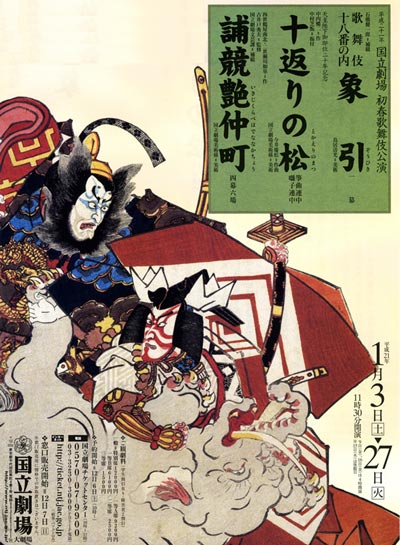| JANUARY 2009 |
|
8 shows in T˘ky˘ (Kabukiza, National Theatre, Asakusa K˘kaid˘, Shinbashi Enbuj˘, Zenshinza Gekij˘), 2 in ďsaka (Sh˘chikuza) and 1 in Ky˘to (Minamiza)!
|
| Kabukiza (T˘ky˘) |  |
| Dates | 3 ~ 27 January 2009 (Kotobuki Hatsuharu ďkabuki) Kabukiza Sayonara K˘en |
| MatinÚe |
Iwau Haru Shiki Sanbas˘ Heike Nyogo no Shima (Shunkan) Sato Moy˘ Azami no Ironui (Izayoi Seishin) |
| Evening | |
| Casting |
Nakamura Kichiemon, Onoe Kikugor˘, Nakamura Kanzabur˘, Band˘ Tamasabur˘, Matsumoto K˘shir˘, Nakamura Tokiz˘, Nakamura Shibajaku, Nakamura Tomijűr˘, Nakamura Baigyoku, Nakamura Kaishun, Nakamura Kinnosuke, Onoe Kikunosuke, Band˘ Hikosabur˘, Onoe Sh˘roku, Ichikawa Somegor˘, Nakamura Karoku, Nakamura Kash˘, Nakamura T˘z˘, Band˘ Yajűr˘, Nakamura Baishi |
| Comments |
January 2009 is an important month for the Kabukiza, which starts its series of 16 Kabukiza Sayonara K˘en (Kabukiza Farewell Performances), which will be held up to April 2010. The year starts with an amazing program, full of all-times favourites:
|
 |
| Sh˘chikuza (ďsaka) |
| Dates | 3 ~ 27 January 2009 (Kotobuki Hatsuharu ďkabuki) |
| MatinÚe |
Yoshitsune Senbon Zakura |
| Evening | |
| Casting |
Sakata T˘jűr˘, Kataoka Nizaemon, Kataoka Gat˘, Nakamura Kanjaku, Nakamura Senjaku, Kataoka Hidetar˘, Ichikawa Danshir˘, Band˘ Takesabur˘, Kataoka Ainosuke, Kataoka Takatar˘, Kataoka Shinnosuke, Band˘ Shinsha, Kamimura Kichiya |
| Comments |
|
| National Theatre (T˘ky˘) |
| Dates | 3 ~ 27 January 2009 (Hatsuharu ďkabuki) |
| Program |
Tokaeri no Matsu Ikiji Kurabe Hadena Nakach˘ |
| Casting |
Ichikawa Danjűr˘, Nakamura Shikan, Band˘ Mitsugor˘, Nakamura Hashinosuke, Nakamura Fukusuke |
| Comments |
This new year program starts with the rare revival of "Z˘hiki", a bombastic play in the aragoto style which belongs to the Kabuki Jűhachiban.
|
 |
| Shinbashi Enbuj˘ (T˘ky˘) |
| Dates | 3 ~ 27 January 2009 (Hatsuharu Hanagata Kabuki) |
| MatinÚe |
|
| Evening |
Koi Bikyaku Yamato ďrai (Fűin Giri) Benten Musume Meo no Shiranami
|
| Casting |
Ichikawa Ebiz˘, Ichikawa Ukon, Nakamura Shid˘, Ichikawa Sadanji, Ichikawa Monnosuke, Ichikawa Danjir˘, Ichikawa Emisabur˘, Ichikawa Emiya, Ichikawa Shun'en, Ichikawa En'ya, Ichikawa Juen |
| Comments |
Second edition of a New Year Program at the Shinbashi Enbuj˘ starring the heir of the Naritaya guild, Ichikawa Ebiz˘. This month he will perform major roles like Igami no Gonta and Benten Koz˘ in "Sushiya" and "Shiranami Gonin Otoko". He will also revive the drama "Nanatsu Men", do a nirami no mie during the k˘j˘, perform a fireman boss role in the short dance "Omatsuri" and play a second role, Aoto Saemon Fujitsuna, in the last scene of "Shiranami Gonin Otoko". Quite a tough challenge for such a dynamic actor! |
|
|||
| Dates | 3 ~ 27 January 2009 (Hatsuharu Hanagata Kabuki) | ||
| MatinÚe | |||
| Evening | |||
| Casting |
Ichikawa Kamejir˘, Ichikawa Omez˘, Nakamura Kantar˘, Nakamura Shichinosuke, Nakamura Kikaku, Onoe Matsuya |
||
| Comments |
The yearly show for young promising actors at the Asakusa K˘kaid˘ in Asakusa, a lively and colorful neighboorhood that keeps the scent of old Edo.
|
||
|
|||
| Dates | 3 ~ 22 January 2009 (Zenshinza K˘en) | ||
| Program |
Izumo no Okuni |
||
| Casting |
Arashi Keishi, Segawa Kikunoj˘, Yamazaki Tatsusabur˘ |
||
| Comments |
This is not a Kabuki drama but a modern play about the legendary woman, who created Kabuki. The script is based on the eponymous novel, who was written by Ariyoshi Sawako. This novel was translated in English by James R. Brandon and published in 1994 under the title "The kabuki dancer". the role of Okuni is not performed by an onnagata but the Zenshinza actress Tsumakura Kazuko. |
||
| Zenshinza Gekij˘ (Kichij˘ji) |  |
| Dates | 3 ~ 12 January 2009 |
| Program |
Futatsu Ch˘ch˘ Yuki no Kowakare |
| Casting |
Kawarasaki Kunitar˘, Fujikawa Yanosuke, Arashi Hironari, Anegawa Shinnosuke |
| Comments |
"Futatsu Ch˘ch˘ Yuki no Kowakare" was a Rakugo story created by San'yűtei Ench˘, the father of "Botan D˘r˘", "Bunshichi Mottoi" or "Shibahama no Kawazaifu". It is adapted to the stage for the first time this month. The play is divided into 3 acts; the first act is a Rakugo performance done by Hayashiya Sh˘jaku. The second and third act are Kabuki. It is about Ch˘kichi, the son of Yaoya Ch˘bŕ, who was placed with the Yamazakiya shop. Along with another servant named Ch˘gor˘, he has the bad habit to steal things. The bant˘ Gonkur˘, who is aware of these petty thefts, prefer to hold his tongue and not report it to the master. Unfortunately for all, Yogor˘, the young heir of the Yamazakiya is desperately in needs of money for the redemption of the courtesan Azuma. The huge sum (100 ry˘) is stolen within the Yamazakiya shop and Gonkur˘ accuses Ch˘kichi, who had no other choice than killing the bant˘ and run away to Northern Japan. The third act is about the return of Ch˘kichi in Edo and his meeting with his parents Ch˘bŕ and Omitsu, which explains the second part of the title Yuki no Kowakare, "separation with a child in the snow". The first part of this title, Futatsu Ch˘ch˘, is an allusion to the famous play "Futatsu Ch˘ch˘ Kuruwa Nikki", which was about the two sum˘tori Ch˘gor˘ and Ch˘kichi. Futatsu Ch˘ch˘ means in fact "the Two Ch˘", Ch˘gor˘ and Ch˘kichi. The courtesan Azuma and her lover Yamazakiya Yogor˘ are also two roles which belong to the "Futatsu Ch˘ch˘ Kuruwa Nikki" world. Featuring Fujikawa Yanosuke (Ch˘bŕ, Gonkur˘), Arashi Hironari (Ch˘kichi) and Kawarasaki Kunitar˘ (Yamazakiya Yogor˘, Azuma, Omitsu). |
|
|
| Contact | Main | Top | Updates | Actors | Plays | Playwrights | Programs | Links | FAQ | Glossary | Chronology | Illustrations | Prints | Characters | Derivatives | Theaters | Coming soon | News |